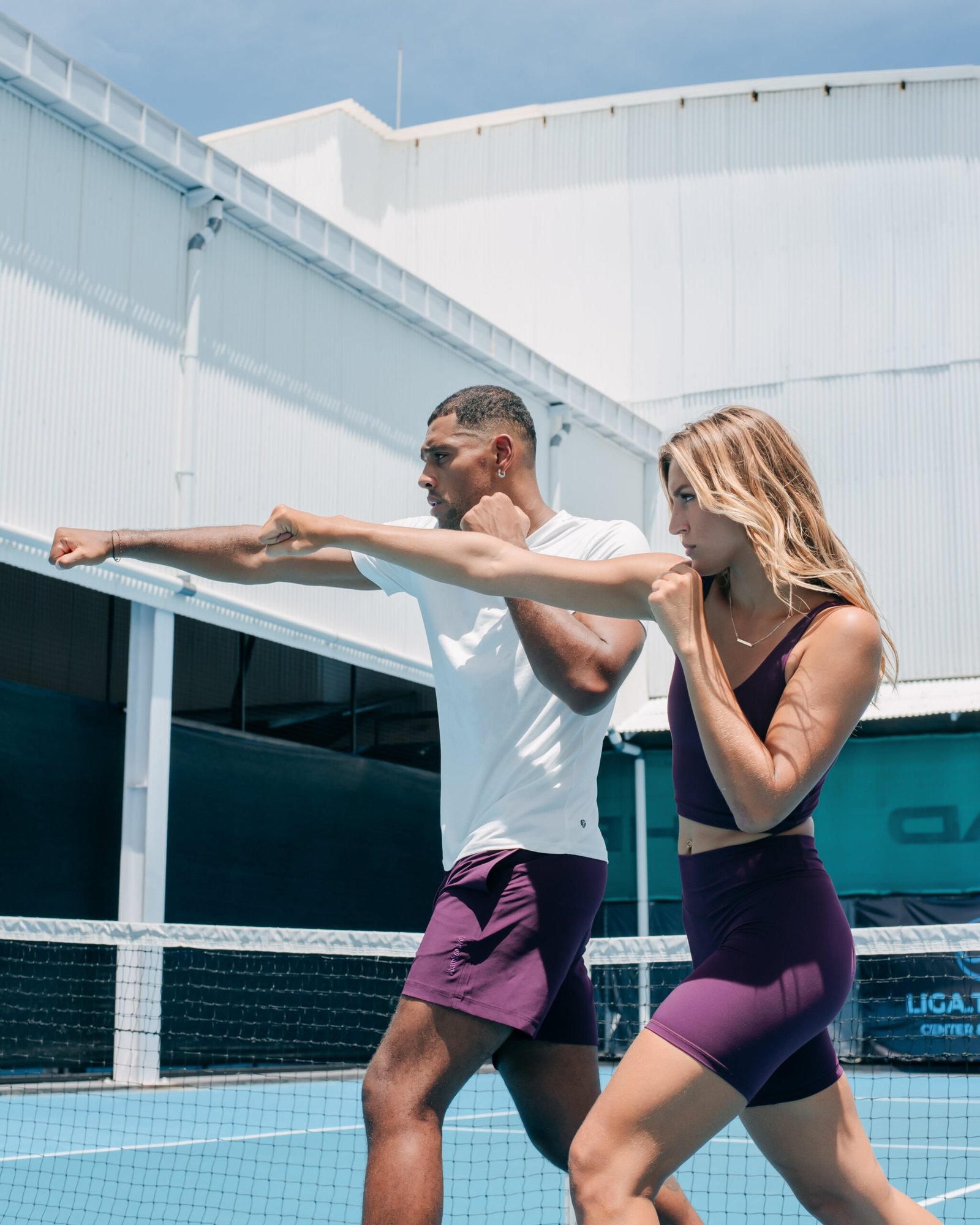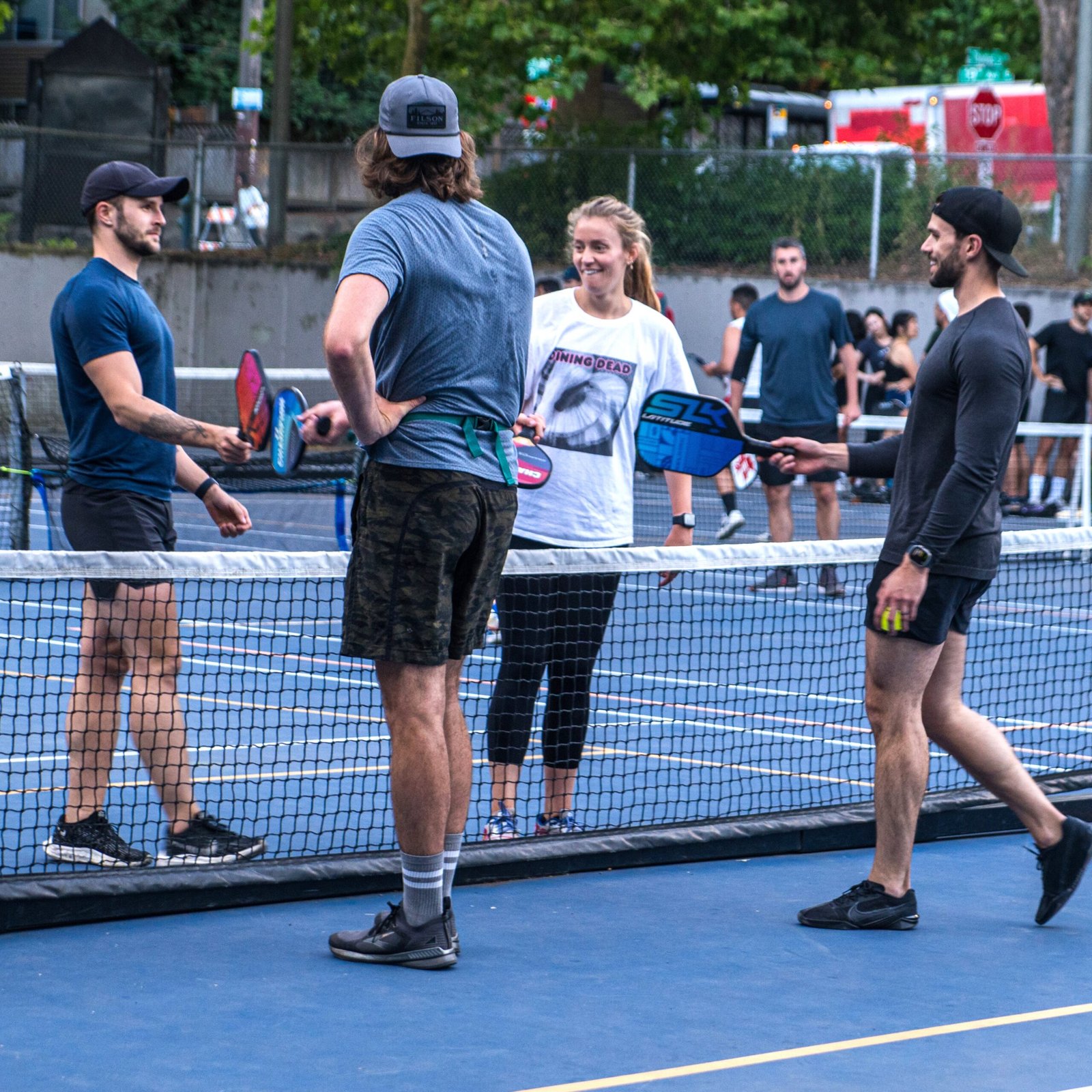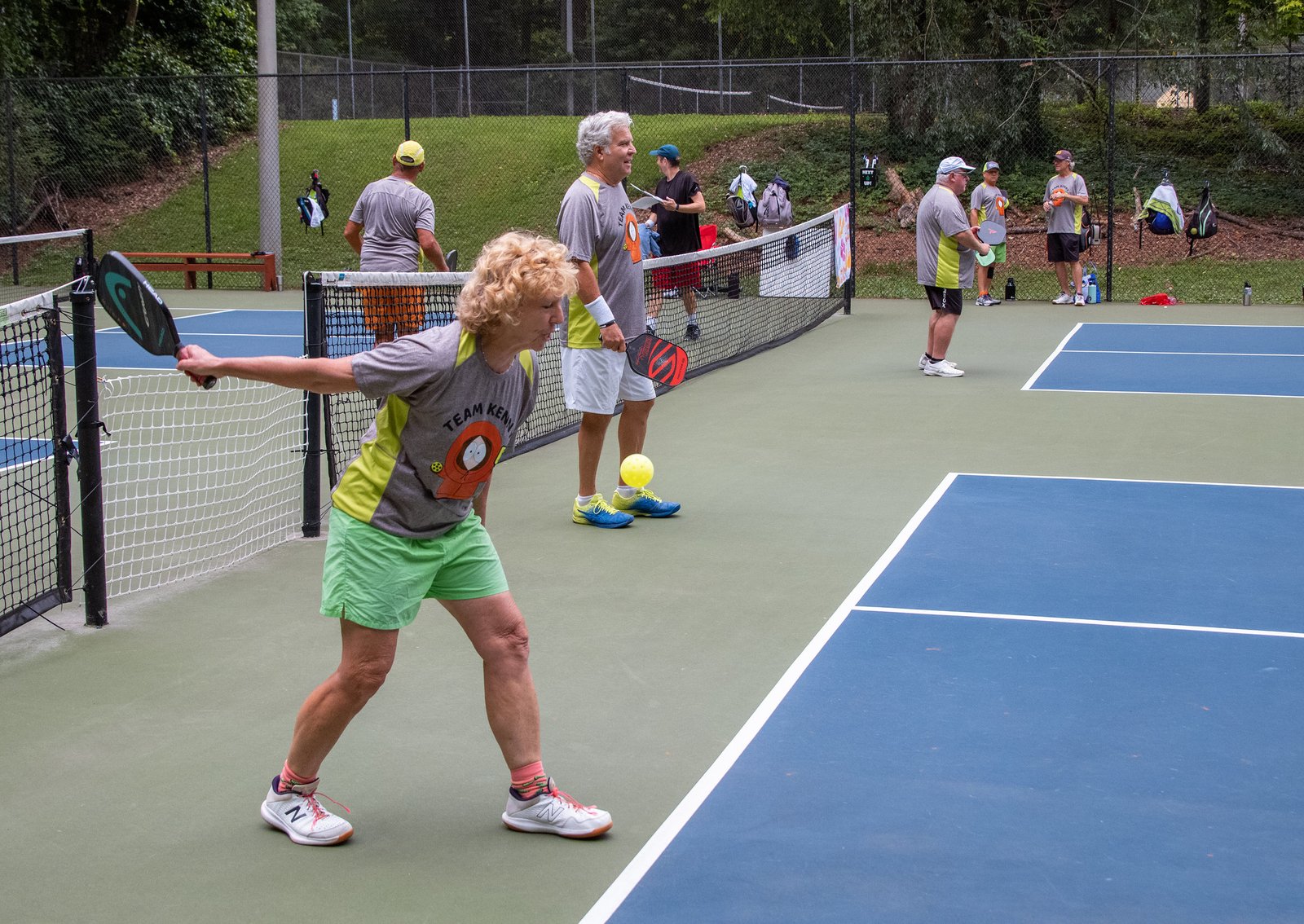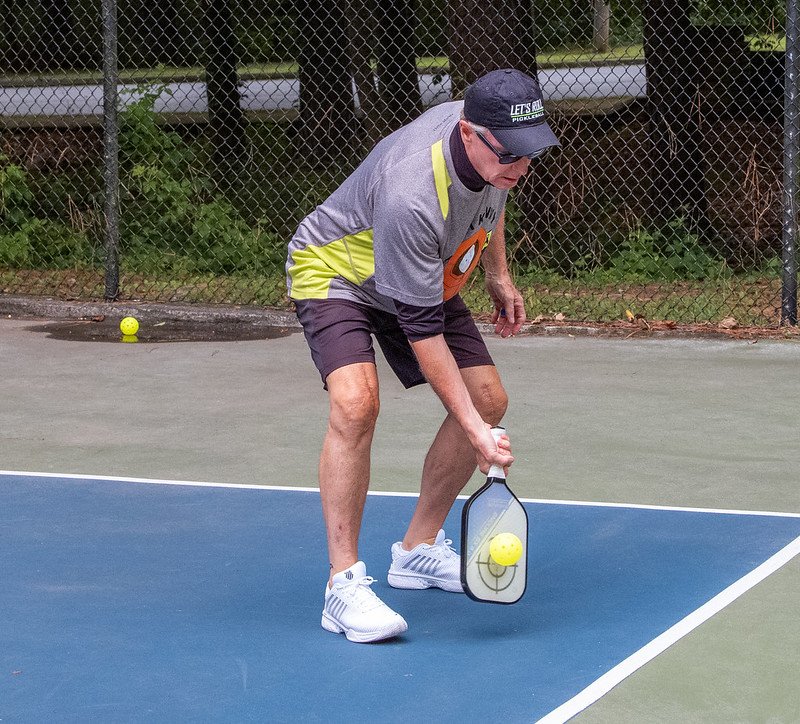Welcome to the comprehensive guide on mastering the game of pickleball and understanding its rules. If you’re eager to embrace the exhilarating world of pickleball, you’ve come to the right place. Pickleball, a fast-paced and exciting sport, is a unique combination of tennis, badminton, and ping pong, played with a paddle and a plastic ball. In recent years, it has gained tremendous popularity across all age groups for its accessibility, engaging gameplay, and the perfect blend of strategy and skill it demands.
Originating in the mid-1960s, pickleball was created by combining elements from various racquet sports to craft a unique, enjoyable game. It’s played on a smaller court compared to tennis, which makes it ideal for players of all ages and fitness levels. The game involves hitting a perforated plastic ball with a paddle over a net, following specific rules and guidelines that enhance the competitive yet enjoyable nature of the sport.
For anyone venturing into the realm of pickleball, comprehending the rules is paramount. The rules of pickleball dictate everything from the serve and scoring to the non-volley zone (often referred to as the “kitchen”). Learning these rules ensures a fair and exciting game, allowing players to compete with understanding and sportsmanship.
Mastering pickleball involves honing a variety of skills, including serving, volleying, dinking, and effective court positioning. With the right techniques and strategies, you can maximize your performance on the court, outwit your opponents, and savor the thrill of victory.
In this guide, we’ll delve deep into the nuances of pickleball, providing insights into the rules, gameplay strategies, essential skills, and tips to elevate your game. Whether you’re a beginner seeking to grasp the fundamentals or an experienced player aiming to enhance your proficiency, we’re here to help you navigate the exciting world of pickleball and embrace the joy it offers. Let’s embark on this pickleball journey and elevate your play to the next level.
Table of Contents
What is a key strategy in pickleball?
A key strategy in pickleball is controlling the “kitchen” or the non-volley zone (NVZ). The NVZ is a seven-foot area on either side of the net where players are not allowed to volley the ball (hit it in the air without it bouncing). This rule adds a unique tactical element to pickleball and significantly influences gameplay.
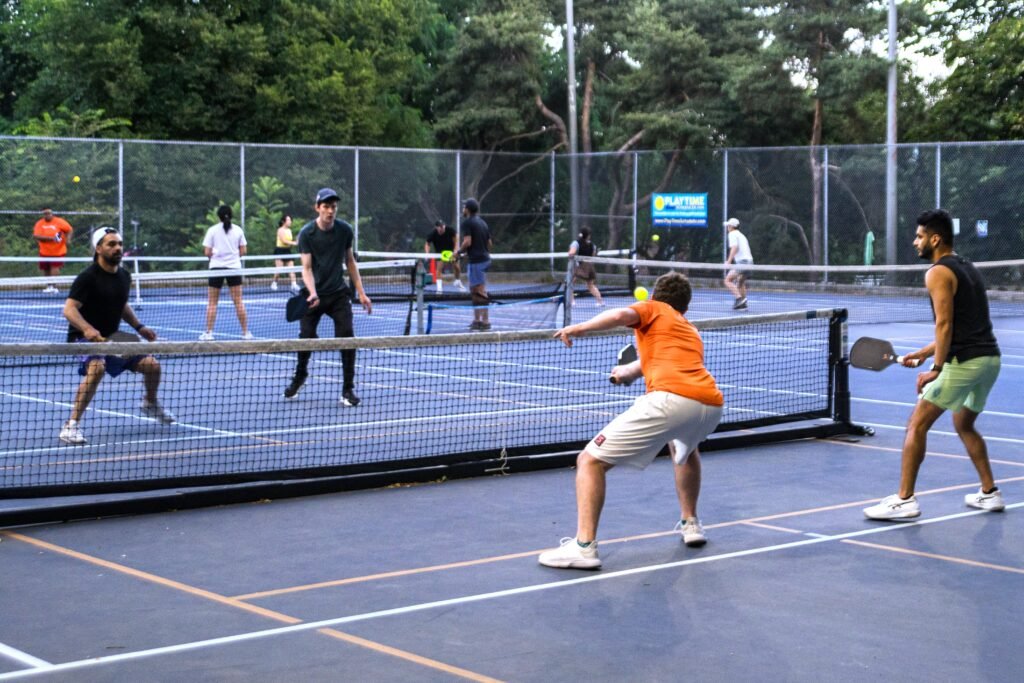
Mastering NVZ control is essential for success in pickleball for several reasons:
Front Court Dominance
By positioning yourself close to the net, you can cut off angles and respond quickly to shots, putting pressure on your opponents. This allows you to dictate the pace of the game and control the net.
Limiting Your Opponent’s Options
When you control the kitchen, your opponents are forced to hit higher, slower shots, giving you a better chance to attack and potentially win points.
Avoiding NVZ Faults
Stepping into the NVZ before hitting a volley results in a fault. Staying in control of this area helps you avoid unforced errors and maintain possession.
Setting Up Winning Shots
When you control the NVZ, you can set up and execute dinks (soft, controlled shots close to the net) effectively. Dinking can force your opponents into making mistakes or create opportunities for winning shots.
To excel in NVZ control, practice your net play, dinking, and volleys. Work on your footwork to ensure you’re in the proper position at the right time. Additionally, communicate and coordinate with your doubles partner to maintain net dominance jointly. By mastering NVZ control, you’ll have a significant strategic advantage in pickleball, enabling you to win more points and enjoy greater success on the court.
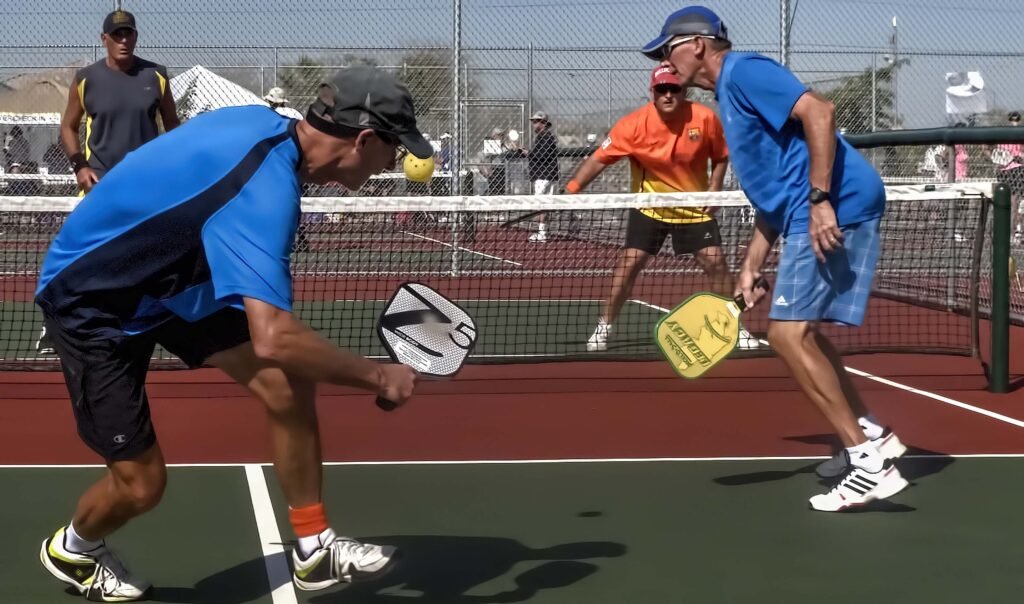
What are the 3 skills needed to play pickleball?
Playing pickleball effectively requires a combination of physical, technical, and strategic skills. Here are three fundamental skills that are crucial for success in the game:
Paddle Control and Ball Placement
Paddle control is a fundamental skill in pickleball. It involves mastering the ability to strike the ball precisely on the paddle’s sweet spot. This skill allows players to control the direction, speed, and angle of their shots. Effective ball placement is equally important, as it enables players to strategically target areas of the court that exploit their opponents’ weaknesses or create opportunities for winning points. Skilled players can consistently place shots near the sidelines, deep in the corners, or just over the net, making it challenging for their opponents to return the ball effectively.
Net Play and Volleys
The net is where many crucial pickleball points are won or lost. Skilled net play involves being proficient at volleys—hitting the ball before it bounces—and mastering the art of the “dink,” a soft, controlled shot that stays low and forces opponents to make difficult returns. Net play requires quick reflexes, soft hands, and the ability to maintain composure during fast-paced exchanges at the kitchen (non-volley zone). Players who excel in this area can dictate the tempo of the game and put pressure on their opponents.
Court Positioning and Footwork
Proper court positioning and footwork are essential skills that help players cover the court efficiently and anticipate their opponents’ shots. Being in the right place at the right time enables players to respond quickly and effectively to incoming balls. Good footwork allows players to move gracefully, maintain balance, and recover from defensive positions. Understanding when to move forward to attack and when to move back to defend is crucial in pickleball, as it allows players to control rallies and stay in advantageous positions.
These skills, combined with an understanding of the game’s rules and strategy, form the foundation for success in pickleball. As players develop and refine these abilities, they can become more competitive and enjoy the game to its fullest.

The Ultimate Guide to Mastering Pickleball
Playing pickleball at a high level involves a combination of skills, strategy, and good sportsmanship. To play the game effectively, you’ll want to focus on various aspects of the game, from technique to court positioning and teamwork. Here’s a detailed guide on how to play pickleball at your best:
Master the Basics
Grip
The grip is the foundational element of your pickleball technique. The recommended grip is the “continental grip,” akin to holding a hammer. With this grip, the base knuckle of your index finger should be on the third panel of the paddle’s handle. This grip allows you to transition seamlessly between forehand and backhand shots. It provides stability and control, enabling you to direct the ball precisely where you want it to go.
Serve
A consistent and accurate serve is crucial to initiate each point effectively. In pickleball, serves are underhand and must clear the net, landing diagonally in the opposite service box. Mastering different types of serves, such as the drive serve and the spin serve, adds variety to your game and can catch your opponents off guard. A well-placed serve can set the tone for the rally and put you in a favorable position.
Volley
Volleys are shots hit before the ball bounces. Practicing volleys is essential to control the pace and direction of the game. Work on maintaining a firm yet flexible wrist, as it allows you to make fine adjustments for precise placement. Being proficient in volleys allows you to seize opportunities at the net and maintain pressure on your opponents throughout a point.
Dink
The dink is a soft, controlled shot that is used primarily near the net. Mastering the dink is crucial for maintaining control during rallies and putting your opponents on the defensive. It requires a gentle touch and finesse to keep the ball low and close to the net, making it challenging for your opponents to attack. Dinking is a strategic skill that can help you gain an advantage by setting up your team for an offensive opportunity or forcing your opponents into making mistakes.
These four skills are the building blocks of a strong pickleball game. Mastering them takes time and practice, but doing so will significantly enhance your ability to compete at a high level and enjoy the sport to its fullest.
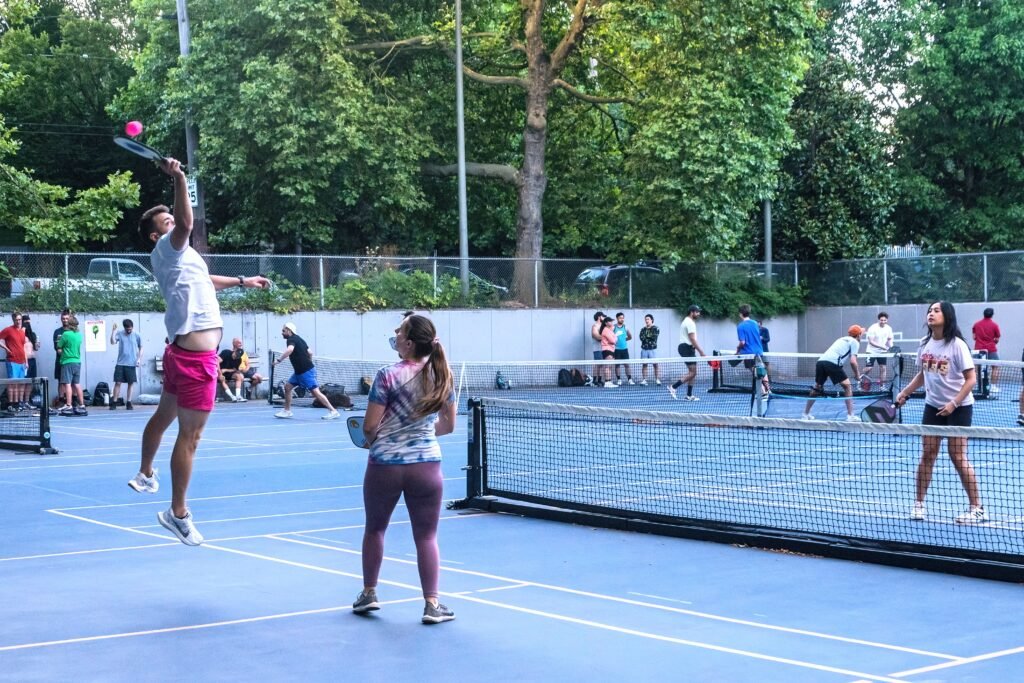
Footwork and Positioning
Effective footwork and court positioning are essential components of success in pickleball. Here’s an expanded explanation of these key principles:
Light and Quick Footwork
Staying light on your feet means being agile and ready to move swiftly in any direction. In pickleball, quick, small steps are preferred over long strides. This agility allows you to respond rapidly to your opponent’s shots and change your positioning on the court as needed. It’s essential to maintain a state of readiness, staying on the balls of your feet to facilitate quick movement.
The “Ready Position”
The ready position is your default stance while playing pickleball. It involves having your knees slightly bent, which helps you maintain balance and react swiftly. Your paddle should be held up and in front of you, ready to strike the ball. This posture allows you to respond rapidly to both low and high shots, ensuring that you are prepared for any situation.
Weight Distribution
Your body weight plays a crucial role in your court positioning. When you’re at the net, keep your body weight forward on the balls of your feet. This forward-leaning posture allows you to pounce on shots near the net and take control of the point. Conversely, when you’re near the baseline, shift your weight slightly backward, enabling you to cover a broader area of the court and return deep shots effectively.
By incorporating these principles into your gameplay, you’ll enhance your agility, responsiveness, and overall court coverage. Mastering footwork and positioning will not only improve your defensive capabilities but also enable you to seize opportunities to take control of rallies and ultimately excel in the game of pickleball.
Strategy
Effective communication is a cornerstone of successful doubles play in pickleball. It involves constant dialogue with your partner to coordinate movements, strategize, and make quick decisions during rallies. Clear communication helps determine who should take specific shots, particularly when balls are hit in the middle of the court or when there’s a potential for overlap. Effective partners establish a rhythm in their exchanges, anticipating each other’s movements to maintain control of the point.
Shot selection is another vital aspect of pickleball gameplay. To keep opponents guessing and maintain the upper hand, players must vary their shots. This means using a combination of dinks (soft, close-to-the-net shots), volleys (hitting the ball before it bounces), groundstrokes (shooting from the baseline), and overheads (smashing the ball at the net). Adapting the pace and angle of your shots is crucial in breaking down your opponent’s defense and creating opportunities to win points.
One of the most critical strategies in pickleball is prioritizing placement over power. While power can be advantageous, precise placement is often more effective. Players should aim for specific target areas such as sidelines, corners, or gaps in their opponents’ court coverage. Well-placed shots force opponents to move out of position, increasing the likelihood of scoring. By mastering these aspects of the game, players can elevate their pickleball performance and increase their chances of success on the court.
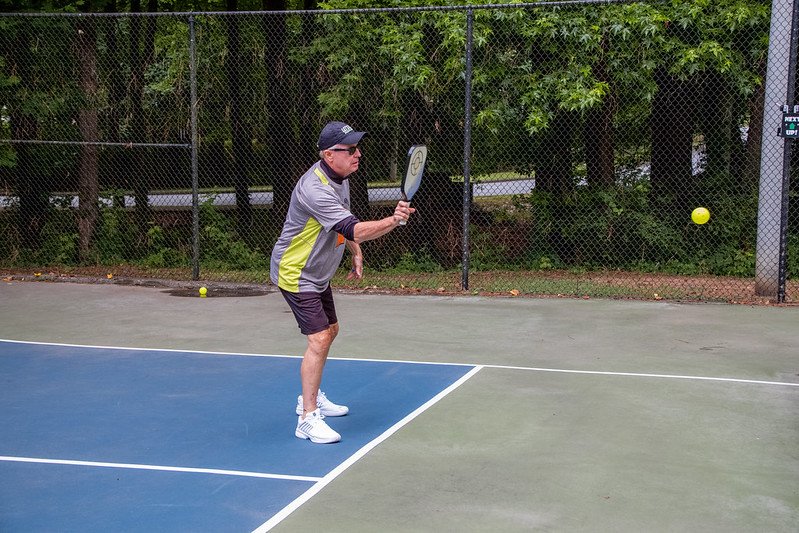
Work on Defense
Effective defense in pickleball is a vital skill that can make a significant difference in your performance on the court. Here’s an expanded explanation of the skills and strategies involved in playing solid defense:
React Quickly to Opponent’s Shots
In pickleball, the pace of the game can change rapidly. Being able to react swiftly to your opponent’s shots is crucial. This requires sharp reflexes and the ability to read your opponent’s intentions by watching their body movements and paddle angle. Quick reactions enable you to get into a good position to make a defensive play.
Anticipate Ball Placement
Anticipation is a key component of defense. By closely observing your opponent’s positioning and paddle angle, you can predict where they are likely to hit the ball. This foresight allows you to move preemptively into a strategic position, increasing your chances of making a successful defensive shot.
Paddle Control for Blocking
Effective blocking involves two essential skills
Firm Paddle Face for Hard Shots
When your opponent hits a hard shot, you need to present a firm and stable paddle face to block it accurately. This minimizes the risk of the ball deflecting unpredictably.
Slight Angle for Soft Shots
When dealing with softer shots or dinks, a slight angle on your paddle face can help you control the ball’s trajectory. This enables you to return the ball softly and accurately, often making it challenging for your opponent to counter.
Incorporating these defensive skills into your pickleball game can help you not only stay in rallies but also turn defense into offense. By reacting quickly, anticipating shots, and using precise paddle control, you can become a more resilient and effective player on the court, capable of handling a variety of situations and opponents.
Practice and Drills
Regular practice is paramount in pickleball to enhance your skills and performance on the court. Devote focused practice sessions to improving key aspects of your game, including serves, volleys, dinks, and court coverage. Work on refining your serves to ensure accuracy, spin, and consistency. Practice volleys to enhance your net play, aiming for control and precision in your shots. Mastering the dink, a soft and controlled shot, will give you an edge during net exchanges.
Incorporate drills into your practice routine, either with a partner or by utilizing a wall. Partner drills can simulate game scenarios, allowing you to work on communication, positioning, and shot selection. Drills against a wall help in honing your reflexes, agility, and technique. Tailor these drills to focus on specific areas you want to improve, whether it’s your backhand, footwork, or reaction time. Consistent, deliberate practice through these drills will contribute significantly to your pickleball proficiency and overall enjoyment of the game.
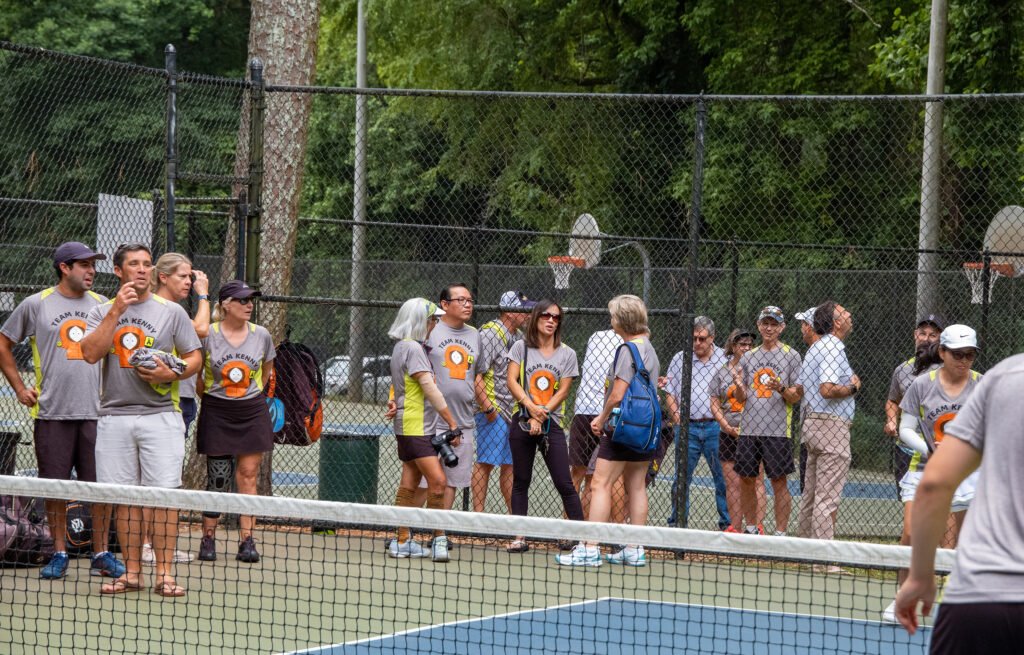
Sportsmanship
Maintaining a positive attitude and demonstrating good sportsmanship on the pickleball court are not just optional niceties; they are integral to the essence of the sport. These behaviors contribute to a more enjoyable and respectful playing environment for all participants.
A positive attitude can have a profound impact on your performance and the overall experience. It helps you stay focused, resilient, and motivated, even in the face of challenging situations or setbacks. It also sets the tone for the game, creating a friendly and welcoming atmosphere where everyone can feel comfortable.
Shaking hands or exchanging pleasantries with opponents before and after a game is a simple yet powerful gesture. It signifies respect for your opponents and acknowledges the shared passion for the sport. It’s an opportunity to connect with fellow players, build camaraderie, and leave the court with a sense of unity and sportsmanship.
Ultimately, pickleball is not just about winning points; it’s about building connections, fostering respect, and enjoying the spirit of competition. By embodying these principles of positivity and sportsmanship, you contribute to the growth and vibrancy of the pickleball community while enhancing your own enjoyment of the game.
Rules and Etiquette
Familiarizing yourself with the rules of pickleball is not only a fundamental aspect of playing the game but also an essential element of maintaining fairness and sportsmanship on the court. Understanding the rules ensures that the game is played correctly, and it helps prevent disputes or conflicts during matches. Key rules to grasp include scoring, which typically involves points being scored only by the serving side and games being played to 11 or 15 points, depending on the specific rules you’re following. Familiarity with faults, such as double bounces, stepping into the non-volley zone, and serving out of turn, helps players avoid making mistakes and understand when their opponents should be awarded points.
Additionally, the non-volley zone rule, often referred to as “the kitchen,” is crucial. It stipulates that players cannot hit the ball in the air while standing in this zone, except when the ball bounces first. Mastering this rule allows players to strategize effectively, knowing when and where to engage in net play.
Equally important is adhering to proper etiquette on the pickleball court. Respect for opponents is paramount. Clear communication of the score is not only a rule but also a sign of sportsmanship. Acknowledging your opponent’s good shots with a nod or a word of praise fosters a positive atmosphere on the court. Overall, understanding and following both the rules and etiquette contribute to a more enjoyable pickleball experience for all players involved, promoting fair competition and camaraderie.

Stay Fit and Hydrated
Pickleball, while accessible and enjoyable for players of all ages and fitness levels, can indeed be physically demanding. As you engage in intense rallies, quick sprints, and agile movements on the court, maintaining good physical conditioning is crucial. Here’s why:
Endurance
Pickleball matches can extend for a significant duration, especially in competitive settings. Building cardiovascular endurance ensures you can sustain your energy levels throughout a match without experiencing fatigue.
Agility and Speed
The ability to move swiftly, change direction, and react to shots is vital. Regular agility and speed training can help you cover the court effectively and respond to your opponent’s moves with precision.
Strength
While pickleball doesn’t require the same level of strength as some other sports, having a strong core and upper body can enhance your shot power and stability at the net.
Flexibility
Flexibility is essential for preventing injuries and optimizing your range of motion during play. Incorporate stretching exercises into your routine to stay limber.
Hydration
Given the physical exertion and potential heat on the court, staying hydrated is non-negotiable. Dehydration can lead to decreased performance, cramping, and even heat-related illnesses. Always have water or a sports drink on hand and drink regularly during breaks in play.
Incorporating a well-rounded fitness regimen that includes aerobic conditioning, strength training, agility drills, and flexibility exercises can significantly improve your pickleball game. Moreover, maintaining good physical shape not only enhances your performance but also contributes to a healthier and more enjoyable experience on the court. So, stay fit, stay hydrated, and relish your pickleball journey to the fullest.
Continuous Learning
Watching professional matches, attending clinics, and seeking feedback from experienced players are invaluable steps in your journey to becoming a skilled pickleball player. Here’s why these actions are essential:
Watching Professional Matches
Observing professional pickleball matches provides you with a wealth of knowledge. You can learn advanced strategies, see how top players handle various situations, and gain insights into their shot selection, court positioning, and decision-making. It’s a great way to study the game at the highest level and apply those observations to your own play.
Attending Clinics
Pickleball clinics and coaching sessions offer structured learning experiences. Knowledgeable instructors can break down techniques, correct your form, and help you develop a deeper understanding of the game’s nuances. Clinics also provide opportunities for drills and practice that can accelerate your progress.
Seeking Feedback
Learning from experienced players or coaches who can provide personalized feedback is invaluable. They can identify your strengths and weaknesses, offer constructive criticism, and suggest specific areas for improvement. This targeted feedback helps you focus your efforts on the aspects of your game that need the most attention, ultimately leading to faster growth as a player.
Incorporating these strategies into your pickleball journey ensures continuous improvement. Remember that the learning process is ongoing, and seeking inspiration and guidance from those who have mastered the game and can take your skills to new heights.
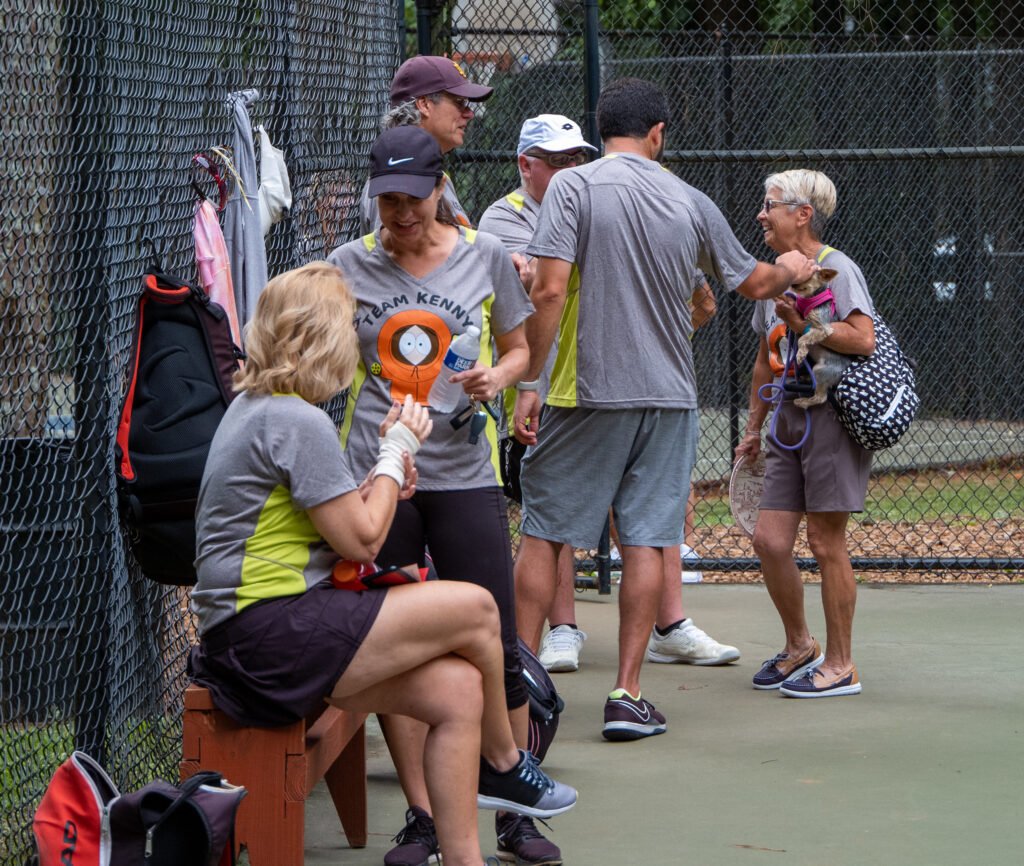
Have Fun
Ultimately, pickleball is more than just a sport; it’s a vibrant community and a source of camaraderie. Beyond the competitive aspect, pickleball is a social activity that brings people together from all walks of life. Whether you’re playing with friends at a local recreational court or participating in organised tournaments, the sense of togetherness and the shared passion for the game create lasting connections.
Pickleball offers a unique opportunity to forge new friendships, strengthen existing bonds, and build a supportive network of fellow players. The sport’s inclusive nature welcomes players of various ages and skill levels, making it accessible to virtually anyone who wants to pick up a paddle and join in on the fun.
As you step onto the pickleball court, remember that the enjoyment of the game and the relationships you form along the way are just as important as winning points. Cherish the laughter, the high-fives, and the moments of shared excitement. Embrace the spirit of sportsmanship and fair play, and you’ll not only become a better pickleball player but also a valued member of this wonderful pickleball community. So, savour every rally, relish every match, and, most importantly, enjoy the game and the camaraderie it offers.
Becoming proficient at pickleball is a journey that demands dedication and persistence. It’s essential to keep in mind that mastery of this sport is not an overnight achievement; instead, it’s a process of continuous growth. Success in pickleball, like any skill-based endeavor, hinges on regular practice, learning from both victories and defeats, and staying committed to gradual improvement.
Embrace the joy of the game, relish the camaraderie with fellow players, and view every match as an opportunity to enhance your skills. Over time, as you invest more hours on the court and hone your technique and strategy, you’ll undoubtedly evolve into a skilled pickleball player who can confidently take on challenges and savor the thrill of competitive play.

